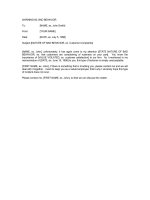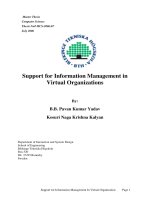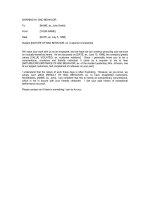94 organizations behavior structure processes 13th
Bạn đang xem bản rút gọn của tài liệu. Xem và tải ngay bản đầy đủ của tài liệu tại đây (95.72 KB, 15 trang )
44 Free Test Bank True – False Questions
16 Free Test Bank Free Text Questions
34 Free Test Bank Multiple Choice Questions
(p. 12) Two important aspects of organizational structure are
job design and organizational design.
1.
2.
True
False
(p. 19) Goal achievement isn't readily measurable for
organizations that don't produce tangible outputs.
1.
2.
True
False
(p. 21) Organizations, such as universities, do not need to
worry about output to survive.
1.
2.
True
False
(p. 6) Groups within an organization have little impact on
individual behavior.
1.
2.
True
False
(p. 16) The planning function is used to determine who'll do
what and with whom, in order to achieve the desired
end results.
1.
2.
True
False
(p. 16) Planning focuses on a single activity: specifying
where the organization is going.
1.
2.
True
False
(p. 9) Learning to manage cultural diversity has become less
important in recent years.
1.
2.
True
False
(p. 11) Without effective leadership practices, instilling
concern about quality is difficult, if not impossible.
1.
2.
True
False
(p. 6) Middle managers must perform both leadership and
follower roles.
1.
2.
True
False
(p. 18) Effectiveness means essentially the same thing to all
people.
1.
2.
True
False
(p. 21) Systems theory emphasizes two important
considerations: (1) an organization must be able to
adapt to the demands of its environment to survive
and (2) the organization must meet those demands.
1.
2.
True
False
(p. 7) Communication and decision making are common
organizational processes.
1.
2.
True
False
(p. 15) Writers of the Classical School proposed that
managerial work consists of distinct yet interrelated
functions, which taken together constitute the
managerial process.
1.
2.
True
False
(p. 9) Managers increasingly work in an unpredictable
economic environment.
1.
2.
True
False
(p. 20) Systems theory can be used to describe the behavior
of both individuals and groups.
1.
True
2.
False
(p. 4) That people work in organizations, produce goods and
services and contribute to society is a phenomenon
limited to the United States.
1.
2.
True
False
(p. 7) An organization chart shows the common processes
within an organization, such as communication and
decision making.
1.
2.
True
False
(p. 20) All organizations acquire resources from the larger
environment of which they're a part.
1.
2.
True
False
(p. 18) The degree of commitment indicates the degree of
effectiveness.
1.
2.
True
False
(p. 22) An organization is considered effective to the extent
that it satisfies the interests of the group controlling
the least important resource.
1.
2.
True
False
(p. 5) The study of organizational behavior isn't a discipline
or a generally accepted science with an established
theoretical foundation.
1.
2.
True
False
(p. 11) Leaders exist within all organizations, regardless of
its location or size.
1.
2.
True
False
(p. 6) Today's workforce looks, thinks and acts very much
like the workforce of the past.
1.
2.
True
False
(p. 11) Very few people in U.S. society are uncomfortable with
the concept of power.
1.
2.
True
False
(p. 23) The purpose of managers in organizations is to
coordinate activities in order to achieve effectiveness.
1.
2.
True
False
(p. 22) Each stakeholder or group of stakeholders expects
the organization to behave in ways that benefit them.
1.
2.
True
False
(p. 9) One of the most powerful influences on individual
performance is an organization's reward system.
1.
2.
True
False
(p. 8) Organizations invariably have a positive cultures,
although the level of positive energy may rise and fall
over time.
1.
2.
True
False
(p. 13) Ethics play a major role in decision making because
managerial decisions affect people's lives and wellbeing.
1.
2.
True
False
(p. 8) Factors in the external environment have an influence
on how an organization is structured.
1.
2.
True
False
(p. 19) Obtaining consensus among managers as to their
organization's specific goals is often the easiest part
of the goal-setting process.
1.
2.
True
False
(p. 12) Job design refers to the process by which managers
specify the contents, methods and relationships of
jobs to satisfy both organizational and individual
requirements.
1.
2.
True
False
(p. 15) Decisional role activities can include the manager
making decisions about negotiations with the
organization's constituencies.
1.
2.
True
False
(p. 10) A reward system is limited to monetary rewards.
1.
2.
True
False
(p. 9) Stakeholder theory attempts to explain and predict how
individual behavior is aroused, sustained and
stopped.
1.
2.
True
False
(p. 9) Group performance is the foundation of organizational
performance.
1.
2.
True
False
(p. 14) If successfully achieving results, a group of chemists
working alone on unrelated projects could be
considered an effective group.
1.
2.
True
False
(p. 22) Managers of an organization achieve effectiveness by
identifying the more influential members of the most
powerful coalitions and satisfying their needs.
1.
2.
True
False
(p. 11) Managers derive their power from organizational
sources only.
1.
2.
True
False
(p. 9) Understanding individual behavior is critical for
effective management.
1.
2.
True
False
(p. 20) In the context of systems theory, the organization is
one element of a number of elements acting
independently.
1.
2.
True
False
(p. 6) A person's behavior in any situation involves the
interaction of that individual's personal characteristics
and the characteristics of the situation.
1.
2.
True
False
(p. 13) Managers seldom, if ever, get to make decisions
involving the allocation of limited resources.
1.
2.
True
False
(p. 10) Conflict among groups always results in benefits for
the organization as a whole.
1.
2.
True
False
34 Free Test Bank for Organizations Behavior
Structure Processes 13th Edition by Gibson
Multiple Choice Questions
(p. 4) Managing people effectively in organizations is the
most essential ingredient for ____________________.
1.
2.
3.
4.
A. Retaining a comfortable standard of living
B. Remaining one of the world's economic leaders
C. Improving the quality of life for all citizens
D. All of the choices are correct
(p. 17) The ____________________ function involves day-today interactions between managers and their
subordinates.
1.
2.
3.
4.
A. Planning
B. Organizing
C. Leading
D. Controlling
(p. 19) The goal approach reflects all of the following except:
1.
2.
3.
4.
A. Achievement
B. Purposefulness
C. Rationality
D. Consistency
(p. 24) Major factors in determining individual and group
behavior are task and _______________ relationships.
1.
2.
3.
4.
A. Occupational
B. Authority
C. Hierarchy
D. External
(p. 21) The ____________________ approach means
achieving balance among the various parts of the
system by satisfying the interests of the organization's
constituency.
1.
2.
3.
4.
A. Goal
B. Contingency
C. Systems
D. Stakeholder
(p. 7) The culture of an organization ____________________.
1.
2.
3.
4.
A. Defines appropriate behavior and bonds
B. Motivates individuals
C. Governs the way a company processes information
D. All of the choices are correct
(p. 3) All of the following are stages that emerge in an
effective global account manager (GAM) system
except:
1.
2.
3.
4.
A. Embedded
B. Remote
C. Spring load
D. Beginner
(p. 18) The ____________________ approach to defining and
evaluating effectiveness is the oldest and most widely
used evaluation approach.
1.
2.
3.
4.
A. Goal
B. Contingency
C. Systems
D. Stakeholder
(p. 16) The organizing function involves designing the
responsibility and authority of each individual job and
____________________.
1.
2.
3.
4.
A. Establishing communication channels
B. Deciding which individuals will be assigned to these jobs
C. Determining which of these jobs will be grouped in specific departments
D. Aligning the jobs within the groups
(p. 11) ____________________ is the ability to get someone
to do something you want done.
1.
2.
3.
4.
A. Authority
B. Persuasion
C. Coercion
D. Power
(p. 8) Every organization must respond to
____________________.
1.
2.
3.
4.
A. The needs of its customers or clients
B. Legal and political constraints
C. Economic changes
D. All of the choices are correct
(p. 20) The concept of the organization as a system that's
related to a larger system introduces the importance of
____________________.
1.
2.
A. Dependency
B. Feedback
3.
4.
C. Goal setting
D. Setting priorities
(p. 18) Employee selection and placement, materials
inspection, performance evaluation and financial
statement analysis are all activities that fall under the
____________________ function.
1.
2.
3.
4.
A. Planning
B. Organizing
C. Leading
D. Controlling
(p. 18) Managers judge as effective those employees who
meet ____________________ standards.
1.
2.
3.
4.
A. Quality
B. Educational
C. Performance
D. All of the choices are correct
(p. 20) Systems theory stresses that every organizations is
part of ____________________.
1.
2.
3.
4.
A. The global system
B. An industry
C. A society
D. All of the choices are correct
(p. 14) An employee's effectiveness can be impacted by
____________________.
1.
2.
3.
4.
A. Motivation levels
B. Attitude
C. Stress levels
D. Any or All of the choices are correct
(p. 16) Planning activities can be ____________________.
1.
2.
3.
4.
A. Complex or simple
B. Implicit or explicit
C. Impersonal or personal
D. All of the choices are correct
(p. 13) When faced with making a choice among several
alternatives, decision makers must consider what is
____________________.
1.
2.
A. Ethical or unethical
B. Good or bad
3.
4.
C. Right or wrong
D. All of the choices are correct
(p. 19) Systems theorists propose that systems can be
categorized by all of the following ways except:
1.
2.
3.
4.
A. Conceptual systems
B. Concrete systems
C. Monetary systems
D. Abstract systems
(p. 6) The basic idea of the ____________________ approach
is that there's no one best way to manage.
1.
2.
3.
4.
A. Goal
B. Contingency
C. Systems
D. Stakeholder
(p. 8) All of the following are the result of a negative culture
except:
1.
2.
3.
4.
A. Hindered behavior
B. Increased productivity
C. Disrupted group effectiveness
D. Hampered impact of a well-designed organization
(p. 15) Henry Mintzberg's study identified all of the following
primary and overlapping managerial roles except:
1.
2.
3.
4.
A. Interpersonal
B. Decisional
C. Informational
D. Organizational
(p. 13) The quality of decision making in an organization
depends on selecting proper goals and identifying a
means for ____________________ them.
1.
2.
3.
4.
A. Documenting
B. Regulating
C. Communicating
D. Achieving
(p. 4) The United States became such a productive nation
largely as the result of ____________________.
1.
2.
3.
4.
A. Sound management practices and techniques
B. Trade embargoes
C. Governmental regulation
D. Its vast array of its natural resources
(p. 16) The organizing function includes all managerial
activities that translate required, planned activities into
a structure of ____________________.
1.
2.
3.
4.
A. Tasks and authority
B. Groups and tasks
C. Goals and achievements
D. All of the choices are correct
(p. 12) An organization's structure is the _______________
pattern of activities and interrelationships among the
various subunits of the organizations.
1.
2.
3.
4.
A. Formal
B. Informal
C. Ad hoc
D. All of the choices are correct
(p. 7) Organizational processes are ____________________.
1.
A. Basic assumptions used by individuals and groups to deal with the organization
and its environment
2. B. Appropriate behaviors within an organization
3. C. Activities that give life to the organization chart
4. D. The formal patterns of how an organization's people and jobs are grouped
(p. 14) All of the following are causes of group effectiveness
except:
1.
2.
3.
4.
A. Norms
B. Attitude
C. Cohesiveness
D. Roles
(p. 5) A(n) ____________________ is a coordinated unit
consisting of at least two people who function to
achieve a common goal.
1.
2.
3.
4.
A. Informal group
B. Formal group
C. Organization
D. Work unit
(p. 10) Managers create work groups to
____________________.
1.
2.
3.
A. Make it easier to manage large groups of employees
B. Carry out assigned jobs and tasks
C. Instill a sense of competition
4.
D. Make it easier to document workflow
(p. 11) The concepts of ____________________ have been
found to be inseparable.
1.
2.
3.
4.
A. Power and quality
B. Competence and leadership
C. Quality and leadership
D. None of the above
(p. 18) The ____________________ function includes
activities that managers undertake to ensure that
actual outcomes are consistent with planned
outcomes.
1.
2.
3.
4.
A. Planning
B. Organizing
C. Leading
D. Controlling
(p. 6) ____________________ are a resource common to all
organizations.
1.
2.
3.
4.
A. People
B. Products
C. Raw materials
D. Customers
(p. 13) Organizational survival is related to management's
ability to ____________________ information.
1.
2.
3.
4.
A. Receive
B. Transmit
C. Act on
D. All of the choices are correct
16 Free Test Bank for Organizations Behavior
Structure Processes 13th Edition by Gibson Free
Text Questions
(p. 21) An organization has two major categories of inputs.
What are they?
Answer Given
Human and natural resources.
(p. 7) ____________________ is the pattern of basic
assumptions used by individuals and groups to deal
with the organization and its environment.
Answer Given
Culture
(p. 15) When does the necessity for managing arise?
Answer Given
The need for managing arises whenever work is specialized and undertaken by
two or more persons.
(p. 10) ____________________ groups form around common
interests and friendships.
Answer Given
Informal
(p. 19) A ____________________ is a grouping of elements
that individually establish relationships with each
other and that interact with their environment both as
individuals and as a collective.
Answer Given
system
(p. 10) As groups function and interact with other groups,
each develops a unique set of characteristics,
including structure, cohesiveness, roles, norms and
processes. In essence, each group creates its own
____________________.
Answer Given
culture
(p. 8) Identify three competencies that a manager must have
to be and remain effective.
Answer Given
Any three of the following: intelligence, a systems orientation, interpersonal skills,
flexibility, self-motivation. Other answers may also be correct, such as technical
ability.
(p. 21) ____________________ refers to information that
reflects the outcome of an act or a series of acts by an
individual, group or organization.
Answer Given
Feedback
(p. 6) Why has the contingency approach grown in
popularity?
Answer Given
Because research has shown that, given certain characteristics of a job and
certain characteristics of the people doing the job, some management practices
work better than others.
(p. 16) The planning function includes two major tasks, the
first being to define the ends to be achieved. What is
the second task?
Answer Given
Determining the appropriate means to achieve the defined ends.
(p. 5) At the most basic level, why are organizations formed?
Answer Given
Organizations are formed to pursue accomplishments that can't be achieved by
individuals acting alone.
(p. 15) The nature of managerial work is to coordinate the
work of individuals, groups and organizations by
performing four management functions. What are
they?
Answer Given
Planning, organizing, leading and controlling.
(p. 5) Identify three of the behavioral sciences that
contributed to the basic framework and principles of
the field of organizational behavior.
Answer Given
Any three of the following: psychology, sociology, political science, cultural
anthropology.
(p. 5) According to the text, there are three levels of
behavior: individual, ____________________ and
organizational.
Answer Given
group
(p. 8) A firm's ____________________ results in shared
thoughts, feelings and talk about the organization.
Answer Given
culture
(p. 8) Identify three symptoms of a negative work culture.
Answer Given
Any three of the following: declining profits, declining quality, declining quantity,
increased absenteeism, increased tardiness, negative employee attitudes. Other
answers may also be correct, such as employee turnover.









